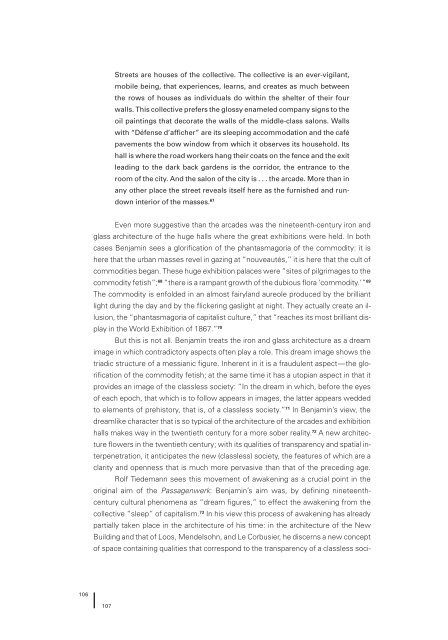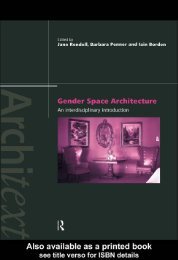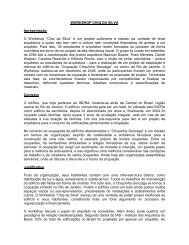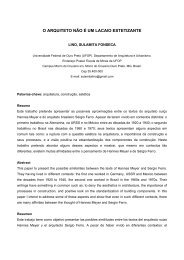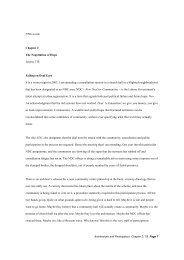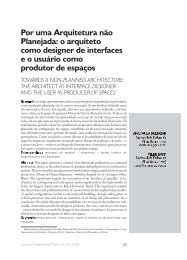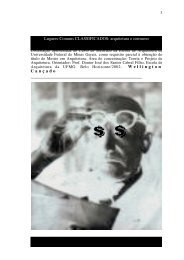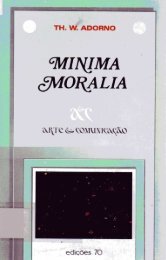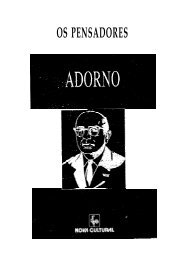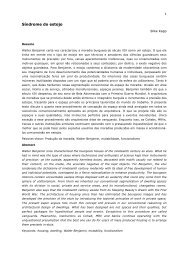Architecture and Modernity : A Critique
Architecture and Modernity : A Critique
Architecture and Modernity : A Critique
You also want an ePaper? Increase the reach of your titles
YUMPU automatically turns print PDFs into web optimized ePapers that Google loves.
106<br />
107<br />
Streets are houses of the collective. The collective is an ever-vigilant,<br />
mobile being, that experiences, learns, <strong>and</strong> creates as much between<br />
the rows of houses as individuals do within the shelter of their four<br />
walls. This collective prefers the glossy enameled company signs to the<br />
oil paintings that decorate the walls of the middle-class salons. Walls<br />
with “Défense d’afficher” are its sleeping accommodation <strong>and</strong> the café<br />
pavements the bow window from which it observes its household. Its<br />
hall is where the road workers hang their coats on the fence <strong>and</strong> the exit<br />
leading to the dark back gardens is the corridor, the entrance to the<br />
room of the city. And the salon of the city is . . . the arcade. More than in<br />
any other place the street reveals itself here as the furnished <strong>and</strong> rundown<br />
interior of the masses. 67<br />
Even more suggestive than the arcades was the nineteenth-century iron <strong>and</strong><br />
glass architecture of the huge halls where the great exhibitions were held. In both<br />
cases Benjamin sees a glorification of the phantasmagoria of the commodity: it is<br />
here that the urban masses revel in gazing at “nouveautés,” it is here that the cult of<br />
commodities began. These huge exhibition palaces were “sites of pilgrimages to the<br />
commodity fetish”; 68 “there is a rampant growth of the dubious flora ‘commodity.’” 69<br />
The commodity is enfolded in an almost fairyl<strong>and</strong> aureole produced by the brilliant<br />
light during the day <strong>and</strong> by the flickering gaslight at night. They actually create an illusion,<br />
the “phantasmagoria of capitalist culture,” that “reaches its most brilliant display<br />
in the World Exhibition of 1867.” 70<br />
But this is not all. Benjamin treats the iron <strong>and</strong> glass architecture as a dream<br />
image in which contradictory aspects often play a role. This dream image shows the<br />
triadic structure of a messianic figure. Inherent in it is a fraudulent aspect—the glorification<br />
of the commodity fetish; at the same time it has a utopian aspect in that it<br />
provides an image of the classless society: “In the dream in which, before the eyes<br />
of each epoch, that which is to follow appears in images, the latter appears wedded<br />
to elements of prehistory, that is, of a classless society.” 71 In Benjamin’s view, the<br />
dreamlike character that is so typical of the architecture of the arcades <strong>and</strong> exhibition<br />
halls makes way in the twentieth century for a more sober reality. 72 A new architecture<br />
flowers in the twentieth century; with its qualities of transparency <strong>and</strong> spatial interpenetration,<br />
it anticipates the new (classless) society, the features of which are a<br />
clarity <strong>and</strong> openness that is much more pervasive than that of the preceding age.<br />
Rolf Tiedemann sees this movement of awakening as a crucial point in the<br />
original aim of the Passagenwerk: Benjamin’s aim was, by defining nineteenthcentury<br />
cultural phenomena as “dream figures,” to effect the awakening from the<br />
collective “sleep” of capitalism. 73 In his view this process of awakening has already<br />
partially taken place in the architecture of his time: in the architecture of the New<br />
Building <strong>and</strong> that of Loos, Mendelsohn, <strong>and</strong> Le Corbusier, he discerns a new concept<br />
of space containing qualities that correspond to the transparency of a classless soci-


